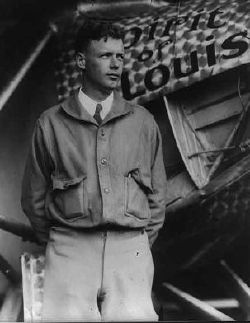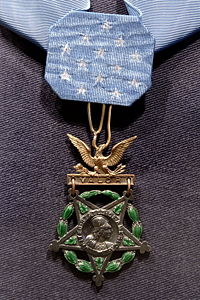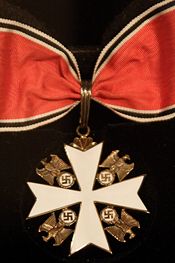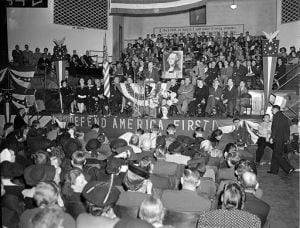Charles Lindbergh
For the U.S. Representative from Minnesota (1859 – 1924), see Charles August Lindbergh
| Charles Lindbergh |
|---|
| Born |
| February, 1902 Detroit, Michigan |
| Died |
| August 26, 1974 Kipahulu, Maui, Hawaii |
Charles Augustus Lindbergh (February 4, 1902 – August 26, 1974), known as "The Lone Eagle," was an American aviator famous for piloting the first non-stop solo flight from New York to Paris in 1927; an event that brought him unprecedented international celebrity, due to the emergence of world wide mass media. His brave sojourn across the lonely Atlantic, a feat perhaps only eclipsed by man’s first walk on the moon, opened the way for a new era in aviation, which in turn, changed our planet by heralding in a new age of global communications and travel.
The trajectory of his life would take Lindbergh from the heralded heights of a hero - of unparalleled fame in the annals of American culture - to the lowest depths of victimization when his son was kidnapped and murdered in what was called the "crime of the century."
In the years prior to World War II, Lindbergh was a noted isolationist, and was a leader in the movement to keep the U.S. out of the coming war. Ultimately, his unpopular stance during the war years was restored in the eyes of the American public when, in 1953, the autobiographical account of his flight, The Spirit of St. Louis, won him the Pulitzer Prize. Lindbergh spent his final years as an ardent conservationist championing the rights of lands, animals, and indigenous peoples like the Tasaday tribal group of the Phillipines.
Early Life
Charles Augustus Lindbergh was born in Detroit, Michigan, the son of Swedish immigrants. His father, Charles Lindbergh Sr., was a lawyer and later a U.S. Congressman who opposed the entry of the U.S. into World War I; his mother was a teacher.
His family owned a small farm in Minnesota and early on, Lindbergh showed an aptitude for all things mechanical. In 1922, due partly to poor grades and a lack of focus, he quit college at the University of Wisconsin-Madison, and joined a pilot and mechanics training program with Nebraska Aircraft. He bought his own plane, a World War I-surplus Curtiss JN-4 "Jenny," and became a barnstormer, the "Daredevil Lindbergh."[1] In 1924, he started training as a pilot with the Army Air Service.
Lindbergh's first job was as chief pilot of an airmail route operated by Robertson Aircraft Co. of Lambert Field in St. Louis, Missouri. As a mail pilot, in those times a dangerous job, he developed a reputation for delivering the mail during any weather conditions.
First non-stop flight New York to Paris
In 1919, frenchman and hotelier Raymond Orteig offered a 25,000 prize known as the Orteig Prize, for any pilot who would be the first to fly from New York City to Paris. His offer spurred a great amount of interest worldwide. Either an easterly flight from New York or a westbound flight from Paris would qualify, consequently, the first challengers were French war heroes, Captain Charles Nungesser and Raymond Coli who took off on May 8, 1927 on a westbound flight in the Levasseur PL 8, nicknamed the L'Oiseau Blanc. The aircraft disappeared after the last known contact was made as the flyers crossed the coast of Ireland. Other teams including famed WWI "ace" René Fonck, Clarence Chamberlin and Admiral Richard E. Byrd, were also in the race to claim the Orteig Prize. The race had become more deadly when Noel Davis and Stanton H. Wooster were killed when the former’s New York to Paris entry crashed.
Lindbergh gained sudden great international fame as the first pilot to fly solo and non-stop across the Atlantic Ocean, flying from Roosevelt Airfield, Long Island), New York to Paris on May 20-May 21, 1927 aircraft The Spirit of St. Louis He needed 33.5 hours for the trip. (His grandson Erik Lindbergh repeated this trip 75 years later in 2002 in 17 hours 17 minutes.) When he landed amidst much fanfare, the President of France bestowed on him the French Legion of Honor. Uponhis arrival back in the United States, a fleet of warships and aircraft escorted him to Washington, D.C. where President Calvin Coolidge awarded him the Distinguished Flying Cross on June 11, 1927.
Lindbergh's accomplishment won him the Orteig Prize; however more significant than the prize money was the acclaim that resulted from his daring flight. A ticker-tape parade was held for him down 5th Avenue in New York City on June 13, 1927.[2] On March 21, 1929 he was presented the Medal of Honor for his historic trans-Atlantic flight.
The massive publicity surrounding him and his flight boosted the aircraft industry and made a skeptical public take air travel seriously. Lindbergh is recognized in the field of aviation for demonstrating and charting polar air-routes, improving upon high altitude flying techniques, and for increasing aircraft flying range by decreasing fuel consumption. These innovations were to become the basis for all modern intercontinental air travel.
|
|
Marriage, children, kidnapping
The couple were married on May 27, 1929, and he taught her how to fly and did much of his exploring and charting of air routes with her. They had six children: Charles Augustus Lindbergh III (1930-1932), Jon Lindbergh (b.1932), Land Morrow Lindbergh (b.1937) Anne Lindbergh (1940-1993), Scott Lindbergh (b.1942) and Reeve Lindbergh (b.1945), a writer.
Charles Augustus Lindbergh III, 20 months old, was abducted on March 1, 1932, from the Lindbergh home. After a nationwide 10-week search and ransom negotiations with the kidnappers, an infant corpse, identified by Lindbergh as his son, was found on May 12] in Jefferson, New Jersey, just a few miles from the Lindberghs' home. More than three years later, a media circus ensued when the man accused of the murder, Bruno Hauptmann, went on trial. Tired of being in the spotlight and still mourning the loss of their son, the Lindberghs moved to Europe in December 1935. Hauptmann, who maintained his innocence until the end, was found guilty and was executed on April 3, 1936.
Pre-war activities
In Europe, during the pre-war period, Lindbergh traveled to Germany several times at the behest of the U.S. military, where he reported on German aviation and the Luftwaffe (air force). Lindbergh was intrigued, and stated that Germany had taken a leading role in a number of aviation developments, including metal construction, low-wing designs, dirigibles, and Diesel engines.
The Lindberghs lived in England and Brittany, France during the late 1930s in order to find tranquility and avoid the celebrity that followed them everywhere in the United States after the kidnapping trial.
While living in France, Lindbergh worked with Nobel Prize-winning French surgeon Dr. Alexis Carrel, with whom he had collaborated on earlier projects when the latter lived in the United States. In 1930, Lindbergh's sister-in-law had ???heart condition. Lindbergh began to wonder why no one could repair hearts with surgery. He discovered it was because organs could not be kept alive outside the body, and set about working on a solution to the problem with Carrel. Lindbergh's invention, a glass perfusion pump, was credited with making future heart surgeries possible.[3] The device in this early stage was far from perfected, however. Although perfused organs were said to have survived surprisingly well, all showed progressive degenerative changes in a few days.[4] Carrel also introduced Lindbergh to eugenics, which would become one of the controversial theories that helped shape Lindbergh's foreign policy views. [5]
In 1929, Lindbergh became interested in the work of U.S. rocket pioneer Robert Goddard. The following year, Lindbergh helped Goddard secure his first endowment from Daniel Guggenheim, which allowed Goddard to expand his independent research and development. Lindbergh remained a key supporter and advocate of Goddard's work throughout his life.
In 1938, Lindbergh and Carrel collaborated on a book, The Culture of Organs, which summarized their work on perfusion of organs outside the body. Lindbergh and Carrel discussed an artificial heart[6] but it would be decades before one was actually built.
Since 2002, the annual Lindbergh-Carrel Prize is awarded at a Charles Lindbergh Symposium for an outstanding contribution to development of perfusion and bioreactor technologies for organ preservation and growth.
The Controversy over the Medal
But his involvement with German aviation brought Lindbergh back into the American limelight once again. In 1938, the American ambassador to Germany, Hugh Wilson, invited Lindbergh to a dinner with Hermann Göring at the American embassy in Berlin. The dinner included diplomats and three of the greatest minds of German aviation, Ernst Heinkel, Adolf Baeumaker and Dr. Willy Messerschmitt. Göring presented Lindbergh with the Service Cross of the German Eagle for his services to aviation and particularly for his 1927 flight. Lindbergh declined to return the medal to the Germans because he claimed that to do so would be "an unnecessary insult" to the German Nazi government. He returned to the United States soon after World War II broke out in Europe.
Lindbergh and Nazi Germany
Because of his numerous scientific expeditions to Nazi Germany, Lindbergh was branded a Nazi sympathizer and consequently PresidentFranklin D. Roosevelt banned him from joining the military. Lindbergh's subsequent combat missions as a civilian consultant restored his reputation with the American public but only partially. However, his much acclaimed and Pulitzer Prize winning biographer A. Scott Berg contends that Lindbergh was not so much a supporter of the Nazi regime as someone so stubborn in his convictions and relatively inexperienced in political maneuvering that he easily allowed rivals to portray him as one, and that in his support for the America First Committee he was merely giving voice to the sentiments of other Americans who opposed entry into World War II. Lindbergh was critical of the Nazi Germany's treatment of Jews, saying in 1941, that "no person with a sense of dignity of mankind can condone."[7] . Lindbergh's fear was that that destroying a powerful European nation would lead to the downfall of Western Civilization and a rise in Communist supremacy over Europe.
America First and anti-war activities
As World War II began in Europe, Lindbergh became a prominent speaker in favor of non-intervention, going so far as to recommend that the United States negotiate a neutrality pact with Germany during his January 23, 1941 testimony before Congress. He joined the antiwar America First Committee and soon became its most prominent public spokesman, speaking to overflow crowds in Madison Square Garden in New York City and Soldier Field in Chicago.
In a speech at an America First rally on September 11, 1941 in Des Moines, Iowa entitled "Who Are the War Agitators?" Lindbergh claimed that three groups had been "pressing this country toward war: the Roosevelt Administration, the British and the Jews" and complained about what he insisted was the Jews' "large ownership and influence in our motion pictures, our press, our radio and our government." Although he made clear his opposition to German anti-Semitism, stating that "All good men of conscience must condemn the treatment of the Jews in Germany," his inability to unequivocally condemn Nazi Germany put him in the position of condoning them.
There was widespread negative reaction to the speech, and Lindbergh was forced to defend and clarify his comments by noting again that he was not anti-Semitic, but he did not back away from his statement. Lindbergh resigned his commission in the U.S. Army Air Corps when President Roosevelt openly questioned his loyalty. After the attack on Pearl Harbor in 1941, Lindbergh attempted to return to the Army Air Corps, but was denied when several of Roosevelt's cabinet secretaries registered objections.
World War II and military service
Charles Lindbergh went on to assist with the war effort by serving as a civilian consultant to aviation companies, beginning with Ford in 1942, working at the Willow Run B-24 production line. Later in 1943, he joined United Aircraft as an engineering consultant. The following year, he persuaded United Aircraft to designate him a technical representative in the Pacific War to study aircraft performances under combat conditions. He showed Marine F4U pilots how to take off with twice the bomb load that the aircraft was rated for and on May 21, 1944 he flew his first combat mission.[8].
In his six months in the Pacific in 1944, Lindbergh took part in fighter bomber raids on Japanese positions, flying about 50 combat missions (again as a civilian). His innovations in the use of P-38s impressed a supportive Gen. Douglas MacArthur.[9] Despite the long range exhibited by the P-38 Lightning leading to missions such as the one that killed Admiral Yamamoto, Lindbergh's contributions included engine-leaning techniques that he introduced to P-38 Lightning pilots. These techniques greatly improved fuel usage while cruising, enabling the aircraft to fly even longer-range missions. On July 28, 1944 during a P-38 bomber escort mission with the 475th Fighter Group, Fifth Air Force, in the Ceram area, Lindbergh is credited with shooting down a Sonia observation plane piloted by Captain Saburo Shimada, Commanding Officer of the 73rd Independent Chutai[10][11]. The US Marine and Army Air Force pilots who served with Lindbergh admired and respected him, praising his courage and defending his patriotism regardless of his politics.[12][13]
Later life and legacy
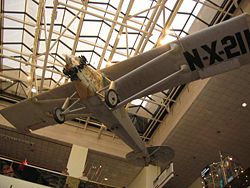
After World War II he lived quietly in Connecticut as a consultant both to the chief of staff of the U.S. Air Force and to Pan American World Airways. Dwight D. Eisenhower restored Lindbergh's assignment with the Army Air Corps and made him a Brigadier General in 1954. In that year, he served on the congressional advisory panel set up to establish the site of the United States Air Force Academy. In December 1968, he visited the crew of Apollo 8 on the eve of the first manned spaceflight to leave earth orbit.
From the 1960s on, Lindbergh became an advocate for the conservation of the natural world, campaigning to protect endangered species like humpback and blue whales. He was also instrumental in establishing protections for the "primitive" Filipino group the Tasaday and African tribes, and supporting the establishment of a national park. While studying the native flora and fauna of the Philippines, he also became involved in an effort to protect the Philippine eagle. In his final years, Lindbergh was troubled that the world was out of balance with its natural environment; he stressed the need to regain that balance.
Lindbergh's speeches and writings later in life emphasized his love of both technology and nature, and a lifelong belief that "all the achievements of mankind have value only to the extent that they preserve and improve the quality of life." In a 1967 Life magazine article, he said, "The human future depends on our ability to combine the knowledge of science with the wisdom of wildness."
In honor of Charles and his wife Anne Morrow Lindbergh's vision of achieving balance between the technological advancements they helped pioneer, and the preservation of the human and natural environments, every year since 1978 the Lindbergh Award has been given by the Lindbergh Foundation to recipients whose work has made a significant contribution toward the concept of "balance".
Lindbergh spent his final years on the Hawaiian island of Maui, where he died of cancer on August 26, 1974. He was buried on the grounds of the Palapala Ho'omau Church in Kipahulu, Maui.
Awards and Decorations
Lindbergh was given many medals. Most were given to the Missouri Historical Society and are on display at the Jefferson Memorial, Forest Park, in St. Louis, Missouri.
- Legion of Honor {French}
- Medal of Honor {USA}
- Distinguished Flying Cross {USA}
- Service Cross of the German Eagle {German}
- Pulitzer Prize (USA)
- Silver Buffalo Award {USA}
- Offical Royal Air Force Museum medal
Lindbergh in pop culture
- Shortly after Lindbergh made his famous flight, the Stratemeyer Syndicate began publishing the Ted Scott Flying Stories (1927- 1943) by Franklin W. Dixon wherein the hero was closely modeled after Lindbergh.
- Charles A. Lindbergh (1927) was a UK documentary by De Forest Phonofilm based on Charles A. Lindbergh's landmark flight.
- A song called "Lucky Lindy" was released soon after the 1927 flight. Tony Randall, not particularly known for singing, but a fan of old songs, revived it in the 1960s in a collection of jazz-age and depression era songs that he recorded.
- The dance craze, the "Lindy Hop" became popular after his flight, and was named after him.
- 40,000 Miles with Lindbergh (1928) was a documentary featuring Charles A. Lindbergh.
- The Agatha Christie book (1934) and movie Murder on the Orient Express (1974) begin with a fictionalized depiction of the Lindbergh baby kidnapping.
- The 1942 film, "Keeper of the Flame," starring Katharine Hepburn and Spencer Tracy, features Hepburn as the wife of a Lindbergh-like national hero who is secretly a fascist.
- Verdensberømtheder i København (1939) was an English/Danish co-production starring Robert Taylor, Myrna Loy and Edward G. Robinson featured Charles A. Lindbergh as himself.
- James Stewart played Lindbergh in the biographical The Spirit of St. Louis (1957), directed by Billy Wilder. The film begins with events leading up to the flight before giving a gripping and intense depiction of the flight itself.
- An alternative history novel, Robert Harris' Fatherland, published in 1992, has Lindbergh as the American Ambassador in 1964 Nazi Germany.
- The American Experience - Lindbergh: The Shocking, Turbulent Life of America's Lone Eagle (1988) was a PBS documentary directed by Stephen Ives.
- British Sea Power wrote, recorded and released (2002) a song in his honor entitled "Spirit of St Louis", a live favorite.
- A fictional version of Lindbergh is a major character in Philip Roth's 2004 alternative history novel, The Plot Against America. In Roth's narrative, Lindbergh successfully runs against Roosevelt in the 1940 US presidential election and aligns his country with the Nazis. This portrayal engendered great controversy.
External links
- Lindbergh's first solo flight
- 1927 Video of Charles Lindberg's Transatlantic Flight
- Lindbergh foundation
- Pat Ranfranz: CharlesLindbergh.com
- Woody Guthrie on Lindbergh
- FBI History - Famous cases: The Lindbergh kidnapping
- PBS companion site to The American Experience program on Charles Lindbergh
- The Lone Eagle: 75 Years Later
- Lindbergh's Public Statements Were More Troubling Than His Private Affairs
- THE AMERICAN AXIS: Henry Ford, Charles Lindbergh and the Rise of the Third Reich
- PBS Article: Charles Lindbergh in the 1940s
- St. Louis Walk of Fame
- Charles A. Lindbergh at the Internet Movie Database
- Recent criticism of Henry Ford and Charles Lindbergh as part of a struggle to define American identity
- Charles Lindbergh: Address On US Neutrality (listen online)
Notes
- ↑ Mosley 1976, p. 46
- ↑ http://roynagl.topcities.com/lindbergh2.htm
- ↑ http://www.luhs.org/about/history.htm
- ↑ http://www.ctsnet.org/edmunds/Chapter1section7.html
- ↑ http://www.pbs.org/wgbh/amex/lindbergh/filmmore/reference/interview/schlesinger03.html
- ↑ http://cardiacsurgery.ctsnetbooks.org/cgi/content/full/2/2003/1507?ck=nck
- ↑ http://www.pbs.org/wgbh/amex/lindbergh/filmmore/reference/primary/desmoinesspeech.html
- ↑ Mersky 1993, p. 93.
- ↑ http://home.st.net.au/~dunn/ozatwar/lindbergh.htm
- ↑ [1]
- ↑ Mersky 1993, p. 93.
- ↑ http://www.homeofheroes.com/wings/part1/8_newwar.html
- ↑ http://www.charleslindbergh.com/history/b24.asp
ReferencesISBN links support NWE through referral fees
- Berg, A. Scott. Lindbergh. New York: G.P. Putnam's Sons, 1998. ISBN 0-399-14449-8.
- Cole, Wayne S. Charles A. Lindbergh and the Battle Against American Intervention in World War II. New York: Harcourt Brace Jovanovich, 1974. ISBN 0-15-118168-3.
- Gill, Brendan. Lindbergh Alone. New York: Harcourt Brace Jovanovich, 1977. ISBN 0-15-152401-7.
- Lindbergh, Charles A. Charles A. Lindbergh: Autobiography of Values. New York: Harcourt Brace Jovanovich, 1977. ISBN 0-15-110202-3.
- Lindbergh, Charles A. We. New York: Grosset & Dunlap Publishers, 1927.
- Mersky, Peter B. U.S. Marine Corps Aviation - 1912 to the Present. Annapolis, Maryland; Nautical and Aviation Publishing Company of America, 1983. ISBN 0-933852-39-8.
- Milton, Joyce. Loss of Eden: A Biography of Charles and Anne Morrow Lindbergh. New York, Harper Collins, 1993. ISBN 0-06-016503-0.
- Mosley, Leonard. Lindbergh: A Biography. New York; Doubleday and Company, 1976. ISBN 0-395-09578-3.
Sources
- Gerd Kröncke: "Der Amerikaner und die Hutmacherin", Süddeutsche Zeitung, August 2, 2003 (German).
- Better Above than Below: [2] By Ellen Chesler, New York Times, March 7, 1993
- Charles Lindbergh:[3]Sept. 11, 1941 speech at Des Moines, Iowa, transcript via PBS.
| Persondata | |
|---|---|
| NAME | Lindbergh, Jr., Charles Augustus |
| ALTERNATIVE NAMES | Lindbergh, Charles |
| SHORT DESCRIPTION | Aviator |
| DATE OF BIRTH | February 4 1902 |
| PLACE OF BIRTH | Detroit, Michigan |
| DATE OF DEATH | August 26 1974 |
| PLACE OF DEATH | Maui, Hawaii |
Credits
New World Encyclopedia writers and editors rewrote and completed the Wikipedia article in accordance with New World Encyclopedia standards. This article abides by terms of the Creative Commons CC-by-sa 3.0 License (CC-by-sa), which may be used and disseminated with proper attribution. Credit is due under the terms of this license that can reference both the New World Encyclopedia contributors and the selfless volunteer contributors of the Wikimedia Foundation. To cite this article click here for a list of acceptable citing formats.The history of earlier contributions by wikipedians is accessible to researchers here:
The history of this article since it was imported to New World Encyclopedia:
Note: Some restrictions may apply to use of individual images which are separately licensed.
